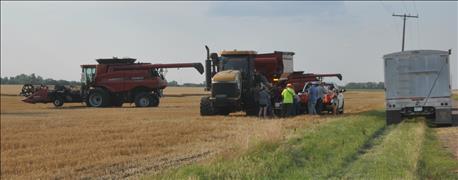
Kansas winter wheat harvest moved to full speed in Sumner County on Friday, a fact made obvious by the fact that there is starting to be one cut field for every one that's still waving in the Kansas breeze.
By late afternoon Friday, Tencleve Farms of Wellington had three combines rolling through a field west of Springdale Road before stopping for a family dinner on a table sandwiched between the grain cart and a semi.
Dennis Tencleve, who farms with his son, Jed, said they expect to be about a third done with his 3,000-acre wheat harvest.

FIELD DINNER: The Tencleve clan gathers between grain cart and semi to enjoy dinner in the field as the harvest rolls in Sumner County.
He said he's up against a weather forecast of possible rain Sunday and a forecast of probable rain on Monday and he's hoping to get as much harvested as possible ahead of that.
"I am not too worried because I have corn and beans and we could use the rain," Tencleve said. "As long as we don't have hail and high winds, just a nice rain, that won't hurt the wheat harvest and it will really help the fall crops."
The winter wheat field Tencleve was harvesting on Friday was Cedar. The last one was Everest, he said. He tried Gallagher, but it wasn't ready.
"I've had yields all the way from 30 bushels in the bad fields to 60 bushels and more in the god fields and I'm averaging around 45," he said. "But the quality has been just awesome. I'm seeing at least 60 pounds test weight and a lot of 62 and 63."
The lowest yields he has seen, he said, are on some of the newer ground he has taken on and is winter wheat behind milo, which doesn't seem to work for him.
As his parents, wife and daughter-in-law spread out dinner on a table at combine-side, Tencleve said is a time of reunion many Kansas farm families, his among them. He farms with his son, Jed, but at harvest time, everybody joins in.
"My dad is 84 and my mom is 82, but they get involved in helping with the meals. They fry up the chicken and everybody chips in for the other stuff. We eat at noon and 6 p.m. so they can get everything cleaned up and the kids ready for bed. None of that eating at 10 p.m. for us."
Harvest takes a crew so the added hands are welcome as it gets rolling.
"Everybody gets here. We have a couple or three friends that take vacation and come and help us for wheat harvest. The grandkids love being here at harvest. They have a high level of excitement. The thing I would say in warning is while that is wonderful, you have to be really, really on your guard and watch out for those little ones when you are moving equipment or vehicles. They run everywhere and you have to watch and double-watch and make sure that they are out of the way," he said.
Tencleve said he delivers most of his harvest to the small co-op elevator at Mayfield because it is the closest to his fields. He also believes in supporting small-town coops in their fight to survive against larger elevators.
This year's harvest is looking good for him at the 30% mark, he said, but he says that after the expenses of inputs like seed, fertilizer, herbicides and fungicides, it takes more money to finish the harvest. His three 8120 Case IH combines, 2 semis and one tandem axle truck and grain cart pulled by a tracked Challenger tractor burn through the fuel.
"We go through 500 gallons of diesel fuel a day during harvest," he said. "And that's just combines and grain carts not even counting the trucks on the road. We have more expenses in a day than many people make in two weeks. And that is just the reality of farming today."
About the Author(s)
You May Also Like






